Summer Field Program Celebrates 75 Years on the Mississippi Gulf Coast
Fri, 05/20/2022 - 03:20pm | By: Jenny Tate
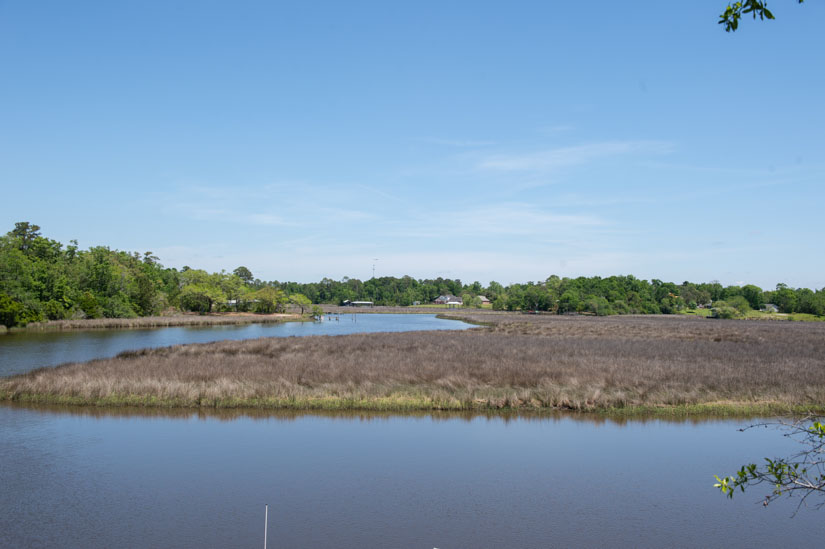 Lasting memories. Lifelong relationships. Career-launching experiences. These are
just a few of the impacts that the Summer Field Program has had on its alumni.
Lasting memories. Lifelong relationships. Career-launching experiences. These are
just a few of the impacts that the Summer Field Program has had on its alumni.
The University of Southern Mississippi's (USM) distinctive Summer Field Program is best described by those who have lived it – past participants and instructors of the intensive program located at USM's Gulf Coast Research Laboratory (GCRL) and nestled along Davis Bayou in Ocean Springs, Mississippi.
Operating since 1947, the Summer Field Program is a residential, hands-on summer learning experience that provides undergraduate and graduate students an unrivaled academic experience studying coastal and marine environments. Participating students experience field trips on USM research vessels, research laboratory work, residence hall living, and a variety of coastal activities.
The program curriculum is offered through two in-person sessions each summer. Session I occurs in June, and Session II occurs in July, with students having the option to attend one or both sessions. Fully online courses are also available, as well as a Research Study Program that allows upper-level undergraduate students an opportunity to design and implement a research project and present research findings.
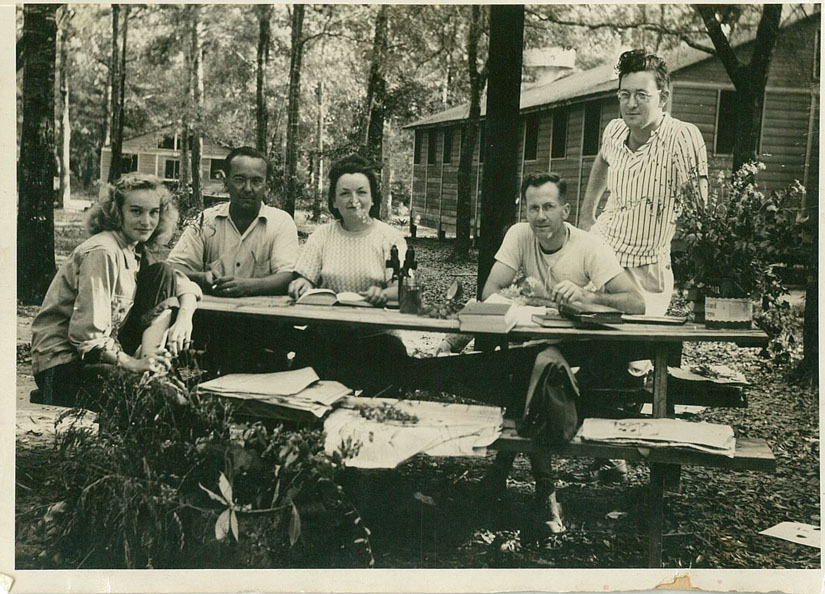 A botany class meets outdoors at Magnolia State Park during the 1947 session.
A botany class meets outdoors at Magnolia State Park during the 1947 session.
The Growth of Summer Field Program
The first official summer field classes took place in the summer of 1947 at Magnolia State Park in Ocean Springs, Mississippi, and quickly grew.
By the summer of 1949, boats were available for field trips to Mississippi's barrier islands, scientific specimens were collected in glass jars, and college students from across Mississippi and neighboring states came to live and learn on the Gulf Coast. In the summer of 1950, courses included botany, invertebrate zoology, general ichthyology, and parasitology, among others. The number of participants grew rapidly, from 40 in 1955 to 80 in 1971.
Two experts who attended and have kept pace with the program for decades are Jim Franks (1963, 1964, 1965) and Harriet Perry (1967, 1968), both Senior Research Scientists with USM's Center for Fisheries Research and Development located at GCRL.
Franks and Perry offered reflections from their time as Summer Field Program participants.
"I first attended the GCRL Summer Field Program as an undergraduate in 1963. My classes were introduction to marine biology taught by Dr. Harry Bennet (Louisiana State University) and ichthyology taught by Dr. Herbert Boschung (University of Alabama). These classes were my introduction to the world of marine science, an experience which made a profound and lasting impression on me," Franks said.
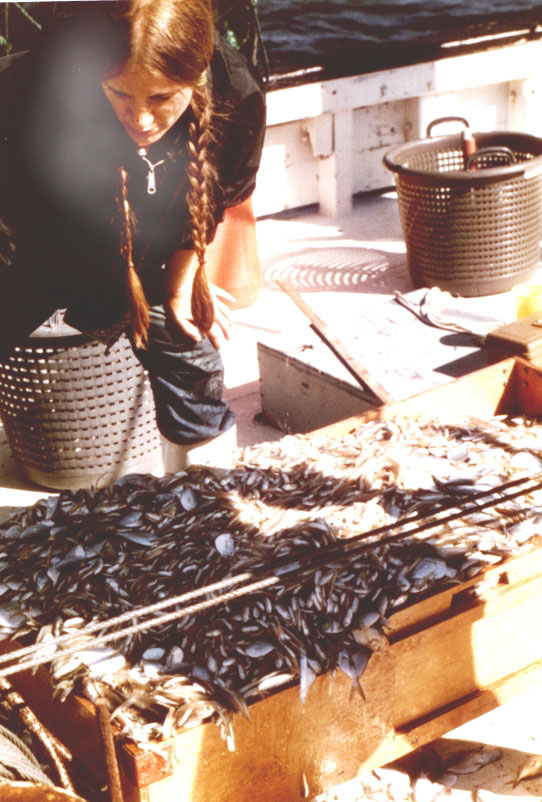
Harriet Perry, pictured here, was one of the first female scientists at GCRL.
According to Perry, "The program in the 'old days' was very intense with a rigorous curriculum. We were immersed in marine science 24/7."
Perry highlighted how special it was to have the ability to meet and learn from pioneers in the field.
"Some of these visitors had written the textbooks and reference materials we used in class. Having the opportunity to meet and speak with these scientists, I now realize, was remarkable. I observed their passion and dedication to the field of marine science, and I believe that this was inspirational to all of us," Perry said.
In addition to being able to meet and learn from pioneering scientists, one of the hallmarks of the program is that participating students hail from across the United States.
To grow the Summer Field Program, Dr. Gordon Gunter, GCRL Director from 1955 to 1971, prioritized developing a network of affiliate colleges and universities that would be involved in and connected to the program.
Throughout the years, external partners and partner institutions have been central to the Summer Field Program's success. Today, the program boasts 63 affiliates from across the United States and includes colleges and universities in 19 states, such as Iowa, Michigan, New York, and Wisconsin.
Alumna Kirsten Larsen (1995, 1996) said, "For me, coming from Wisconsin, I had only been to the ocean once before arriving at GCRL, so this was literally a dream come true – tramping through the marsh, riding boats, collecting and learning about the marine animals. Taking several trips out on the R/V Tommy Munro and pulling a deep-water trawl for the first time – I had never seen many of these animals ever before!"
Larsen's experiences were echoed by alumnus Kevin Hamed (1995).
"My favorite experiences were the field trips to Horn Island! I can still remember the field trips and the incredible hands-on learning that occurred. Having dolphins ride the wake of the R/V Hermes on the journey back to GCRL was always a great end to the trip," Hamed said.
Following Summer Field Program, Hamed earned a Master of Science in biology and a Ph.D. in natural resources. He currently serves as the Collegiate Assistant Professor of Wildlife Conservation and Collections Curator at Virginia Tech's Department of Fish and Wildlife Conservation in Blacksburg, Virginia.
"When I reflect on my academic journey as a student, my time at GCRL was the greatest experience of my educational career. I continue to share much of what I learned and experienced with my students," Hamed said.
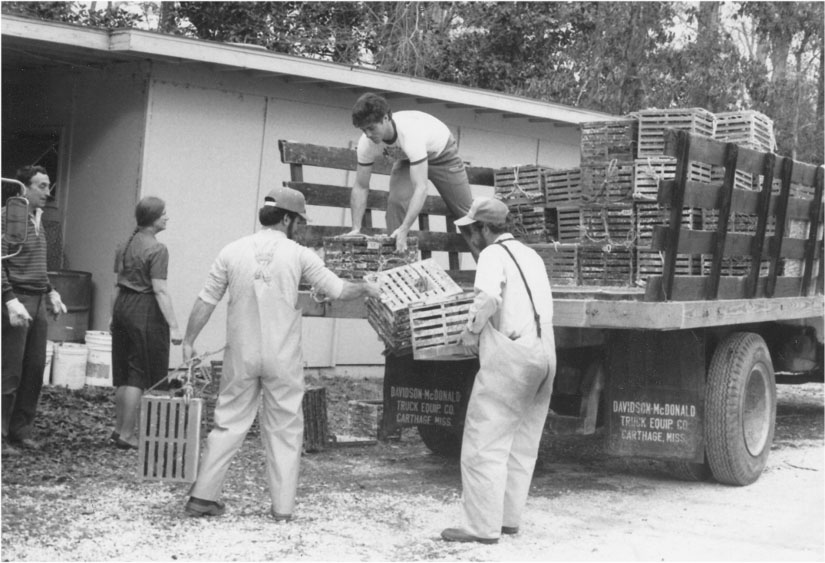 Harriet Perry, second from left, was one of the first female scientists at GCRL.
Harriet Perry, second from left, was one of the first female scientists at GCRL.
The Impact of Summer Field Program
In its early days, the Summer Field Program was designed for upper-division undergraduate students, typically college juniors and seniors, and evolved to offer coursework for upper-division undergraduate students and graduate students. Most classes are conducted in an intense laboratory and field setting, offering numerous hands-on learning opportunities including exploring the Mississippi Sound and nearby barrier islands on USM research vessels.
Participating students can fully embrace living near the Gulf of Mexico and study the unique habitats found in the region.
Hamed said, "Every time I hear laughing gulls, I remember sunrises at GCRL and watching Davis Bayou wake up each day."
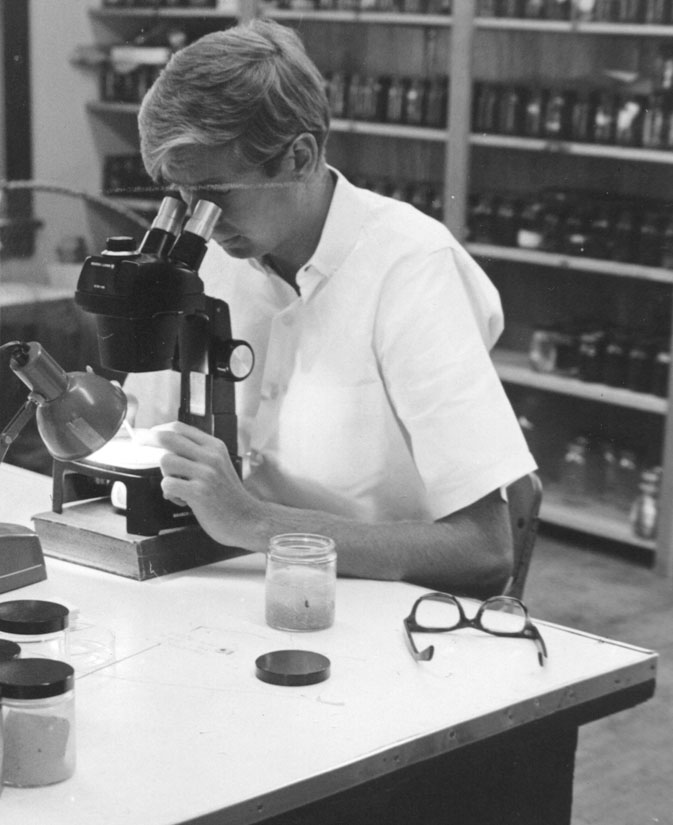
Jim Franks conducts lab work in 1967.
Jim Franks also reminisced about what he observed and experienced during his first boat trip.
"Crossing the Mississippi Sound for the first time, experiencing the beauty of Horn Island and the amazing diversity of marine life in the shallows along the beach, and collecting specimens throughout the day to bring back to the lab for my class to identify and study was an 'eye-opening adventure' for me."
"I'd never seen any of those life forms before," Franks added.
Many of the courses are taught by those who went through the program as students, like Franks.
As a USM research scientist and Summer Field Program instructor, Franks has inspired countless individuals to explore and study the ocean and coastal environments, including alumna Nikola (Kola) Garber (1993-1996).
Garber described how a seminar taught by Franks jumpstarted her career trajectory.
"As fate would have it, Jim was giving an evening seminar on everything known about cobia. Now, I needed to write a report for my ichthyology class, and this fish sounded like the perfect topic," Garber said.
"After negotiations with my teacher to change my topic – 'only if Jim agrees' was his response – and a discussion with Jim to allow me to access his literature and everything stored in his brain, I had my paper topic," she said. "More importantly, I gained a lifelong friend, mentor, fish sampler, and research companion!"
Following Summer Field Program, Garber earned a Master of Science in marine science/molecular biology and a Ph.D. in international development, both from USM. She is the Deputy Director and Acting Assistant Director for Partnerships for the National Oceanic and Atmospheric Administration's (NOAA) National Sea Grant College Program and credits the Summer Field Program for "setting in motion a series of events that has allowed me to be where I am today."
The Summer Field Program Today
This year, the Summer Field Program celebrates 75 years of providing unique educational opportunities for those who go on to become future professors, researchers, directors, veterinarians, biologists, and more.
Three-quarters of a century of learning about the coastal and marine environments has brought many new, eager young individuals to experience the salty summer air and warm waters of Coastal Mississippi.
Johnny Shelley attended Summer Field Program in the early 2000s as an undergraduate and graduate student. Following the program, Shelley earned a Doctor of Veterinary Medicine from Louisiana State University's School of Veterinary Medicine. He serves as Veterinary Medical Officer with NOAA's Seafood Inspection Program based out of the National Seafood Inspection Laboratory in Pascagoula, Mississippi, and is the Institutional Animal Care and Use Committee Attending Veterinarian for the USDA-ARS Aquatic Animal Health Research Unit in Auburn, Alabama.
"I can honestly say that if it were not for the GCRL Summer Field Program, my life and professional journey would have been very different, and I do not think I would have become a fish veterinarian," Shelley said. "I would not be where I am, or the person I am, without the experiences I had while on the Mississippi Gulf Coast."
Larsen, who earned a Master of Science in biology with a fisheries emphasis from USM, said, "Attending the Summer Field Program at GCRL launched my entire career. My first term I did an independent study with one of the researchers and was able to experience the day-to-day of working in a marine research laboratory. I was able to work closely with the entire Fisheries team, which eventually enabled me to get a full-time position at GCRL following graduation."
Today, Larsen serves as the Marine Ecosystem Section Chief for NOAA's National Centers for Environmental Information and is based at the John C. Stennis Space Center.
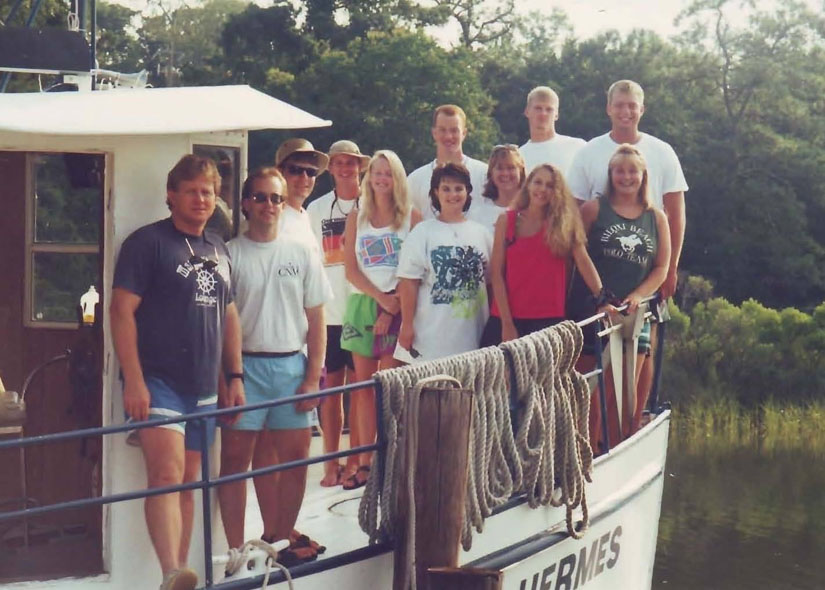
Read Hendon, fourth from left, and classmates participate in a 1995 marine ichthyology class aboard the R/V Hermes.
GCRL Director and Summer Field Program alumnus, Read Hendon (1995, 1996), says the program can offer lasting positive professional and personal impacts.
"Not only will you have a unique and life-changing academic experience, but you will also make connections that will last for years," Hendon said.
"After my first Summer Field Program session, I ended up enrolling in graduate school at GCRL under Dr. Mark Peterson, who was one of my instructors, and from there was hired into GCRL's fisheries program. So, the Summer Field Program truly did set the course for my career."
Summer 2022 enrollment is anticipated to be around 125 students, with the majority of those students spending their summer in South Mississippi for the very first time.
For someone curious about the program, Larsen encourages, “Absolutely go for it! If the classes are full, inquire about doing an independent project with one of the other many faculty or staff.”
To learn more about the Summer Field Program, visit usm.edu/SFP.